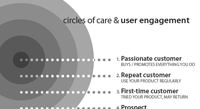I first encountered the Kano model when working on improving the customer’s check-in experience at Copenhagen Airport. The model was conceived by Noriaki Kano in the 80s, and helps you analyze the customer experience of your product (or service), which ultimately allows you to invest more wisely in customer experience improvements.
The Kano model assumes three different attribute types – basic, performance, and delight – that collectively constitute the customer experience of your product.
The Kano model can help you analyze the customer experience of your product.
The three attribute types are mapped in a coordinate system with “Customer Satisfaction” up the y-axis and “Degree of Achievement” (how well a given feature is executed in your product) along the x-axis.
Let’s take an in-depth look at each of these attribute types along with some examples.
Basic Attributes
Basic attributes are typically taken for granted so customers only take notice when you fail to deliver.
Basic attributes represent features that are so basic to the product that your customers just expect them to work. These features are often taken for granted so customers rarely consciously look for them.
Examples of basic attributes are:
- For a service like air travel it might be that your flight won’t be cancelled or that having a ticket guarantees you a seat on the flight.
- For a web application like Gmail it might be that it’s always available (close to 100% uptime) or that when you press send the email will in fact be sent to the recipient within seconds.
- For an application like iTunes it might be that once you have purchased a song you get to play it as often as you like.
When dealing with basic attributes there’s not a direct relationship between the degree of achievement and customers satisfaction. When basic attributes are achieved your customer won’t be particularly satisfied, as he assumes it goes without saying. But when you leave out a basic attribute it doesn’t matter how well you otherwise perform or delight, the entire customer experience is broken. In this sense, it is difficult to actively use basic attributes as a competitive advantage, but if you fail it will put your company at a severe competitive disadvantage.
Performance Attributes
Performance attributes are rife with competition and it can be cost-prohibitive to be best-in-class on everything.
Performance attributes are features where there is a direct correlation between the degree of achievement and customer satisfaction. As a consequence companies perform a UX competitive analysis, differentiating their product by spending more (or less) than their competitors on certain performance attributes.
Examples of performance attributes are:
- For air travel it might be how much legroom you have (first & business class gets more than economy class) or how many stops there are on your journey.
- For Gmail it might be the amount of free storage space.
- For iTunes it might be the number of codecs and file formats that can be imported.
The logic goes: the more legroom you offer your passengers, the more satisfied they will be. The steps are evolutionary, not revolutionary, and there’s typically a cost directly tied to the degree of achievement which is why performance attributes are natural candidates for competition (although winning that battle can be tricky).
Delight Attributes
Delight attributes are difficult to achieve but once you do the returns can be exceptional.
Delight attributes represent the unexpected – when you delight the customer by over-delivering or doing something out of the ordinary.
Examples of delight attributes:
- For air travel it might be getting food that actually tastes good.
- For Gmail it might be Priority Inbox that intelligently label and sort your unread mail.
- For iTunes it might be wireless syncing of apps and music.
Like the basic attributes, when dealing with delight attributes there’s not a linear relationship between customer satisfaction and the degree of achievement. When a delight attribute isn’t there the customer experience isn’t affected negatively because – by definition – delight attributes are never expected by the customer. However, when a customer is faced with a delight attribute it completely takes them by surprise, often resulting in over-excitement with your product, making it an effective engine for word-of-mouth.
Ever-Increasing Customer Expectations
One of the most important aspects with the Kano model is how time affects the attributes. Customer satisfaction with a given feature will deteriorate over time as companies start compete on the feature and customers get accustomed to it.
People quickly get accustomed with new features and raise their expectations accordingly which means you must constantly invent new ways to delight and perform.
When Gmail was introduced and offered 1GB free e-mail accounts it was revolutionary and the customer satisfaction was monumental – clearly a delight attribute. Nowadays, most free e-mail accounts offer similar storage capacity, to the point where ordinary users never have to worry about it. It has clearly moved from delight to performance, and is even starting to become a basic attribute.
So what today is a delight attribute that customers get truly exited about, will eventually degrade into a performance attribute as the competition starts to follow up and compete on providing the same thing (or even improving upon it). Eventually a feature reaches a state where further improvements are so inconsequential that they only matter when you fail to deliver – at this point it has become a basic attribute.
Hint: in an entertaining interview Louis CK describe this dilemma of ever-increasing customer expectations quite well.
Takeaways from the Kano model
So how do you use the Kano model in to your current or upcoming web projects? Besides analyzing the customer experience of your product, the Kano model can be useful when reflecting on how to invest more wisely in improving your customer experience. The following takeaways are particularly useful during this process:
- The details don’t matter if you don’t get the fundamentals right, so the basic attributes need to work flawlessly before you focus on anything else.
- You don’t need to match every single performance attribute in the market head-on. Align your investments in performance attributes with the target audience of the product – this may of course vary significantly and warrant different variations of the same product.
- Delivering unexpected delight attributes is what fuels word-of-mouth. Once you’ve secured the basic attributes and some performance attributes, you should begin brainstorming on what delight attributes you can offer as this is what will truly set you apart from the competition.
- Today’s delight attribute is tomorrow’s performance attribute, and six months from now it may very well be a basic attribute. Customer expectations continually increase so you have to continually reiterate and reinvent your offerings.
- Having a deep understanding of the true needs of your customers, their context and their behavior, is absolutely crucial when inventing new delight attributes. Looking at what your competitors are doing won’t help much as the delight attribute will no longer be a delight by the time you have imitated it.









